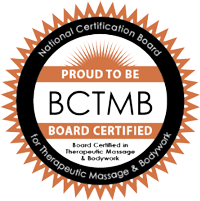News: April 2022
Diaphragmatic Breathing - Easier Said Than Done
 Anxiety is accompanied by shallow, inefficient breathing. Many of us even hold our breaths without realizing it. Breathing is something most people don't think about, but can be at the root of dysfunction in the body.
Anxiety is accompanied by shallow, inefficient breathing. Many of us even hold our breaths without realizing it. Breathing is something most people don't think about, but can be at the root of dysfunction in the body.
Optimal respiration utilizes the diaphragm, our primary breathing muscle. In diaphragmatic breathing, the belly rises and falls, and chest movement is minimal. During inhalation, the diaphragm moves downward to expand the thoracic cavity, which allows the lungs to take in more air. This means more oxygen into the bloodstream, which activates physiological processes in the body that reduce stress. Try it here!
When anxious or stressed, only the chest expands during inhalation, and neck and shoulder muscles strain to assist. This "chest breathing" is appropriate in a temporary "fight or flight" situation. The problem is, so many of us live every day in a state of fight or flight, and that is when this type of breathing creates physical and emotional imbalance. The reverse is also true - chest breathing promotes a state of high stress in the body and brain.
Breathing patterns also directly influence posture. Diaphragmatic breathing increases trunk stabilization, which is essential for controlling posture from head to toe. In contrast, chest breathing pulls the ribcage out of alignment, causing compensatory patterns that then misalign the entire shoulder complex.
The result is shoulder pain that won't go away. We can try to strengthen and stretch the shoulder all we want, but unless we address the underlying breathing and postural dysfunctions, the shoulder will continue to complain.
The good news is that proper breathing and posture can be learned. Like learning any new skill, the new patterns will take time and repetition before they become natural. But just by correcting these two fundamental elements, you can decrease stress and anxiety, move with more efficiency, have more energy, reduce pain and stiffness, and decrease your risk of injury.
There are many online sources that can help get you started. My YouTube channel has a bunch of videos on breathing and postural alignment. But the best way to improve your breathing and posture is with the in-person help of a massage therapist, physical therapist, or other specialist. I am here to help as well, so don't hesitate to reach out. Together, we can get you on the path to better physical and emotional health!
Source: Corrective Exercise: A Comprehensive Guide to Corrective Movement Training by Chad Waterbury, DPT
Relieve Lower Back Pain with Relaxing Self-Massage
An estimated 80% of Americans experience back pain at some point in their lives. The World Health Organization (WHO) reports, "Low back pain is the leading cause of activity limitation and work absence throughout much of the world, imposing a high economic burden on individuals, families, communities, industry, and governments." The WHO also estimates the prevalence of non-specific lower back pain in industrialized countries is 60% to 70%.
Self-massage is a safe and effective way to treat many types of lower back pain - and also prevent it! Join me for this relaxing lower back self-massage that is easy to follow, and will relieve tension and allow your back muscles to melt and unwind.
Practice these self-massage techniques regularly (3-7 days/week) for longer lasting effects, or to prevent pain and keep your lower back healthy.
Source: World Health Organization
What's new with me ...
I earned my certification as a Corrective Exercise Specialist! The course took me deeper into understanding movement dysfunctions that can cause pain and restriction, and how to treat them with functional exercises. I'm now working towards my Sacroiliac Joint Specialist Certification. I love learning more ways to help you!

Call or text me today
917-359-8641
I'd be happy to answer
any questions you have!
Massage@Rachel-Richards.com
Subscribe to my Youtube channel!
Did you know?





